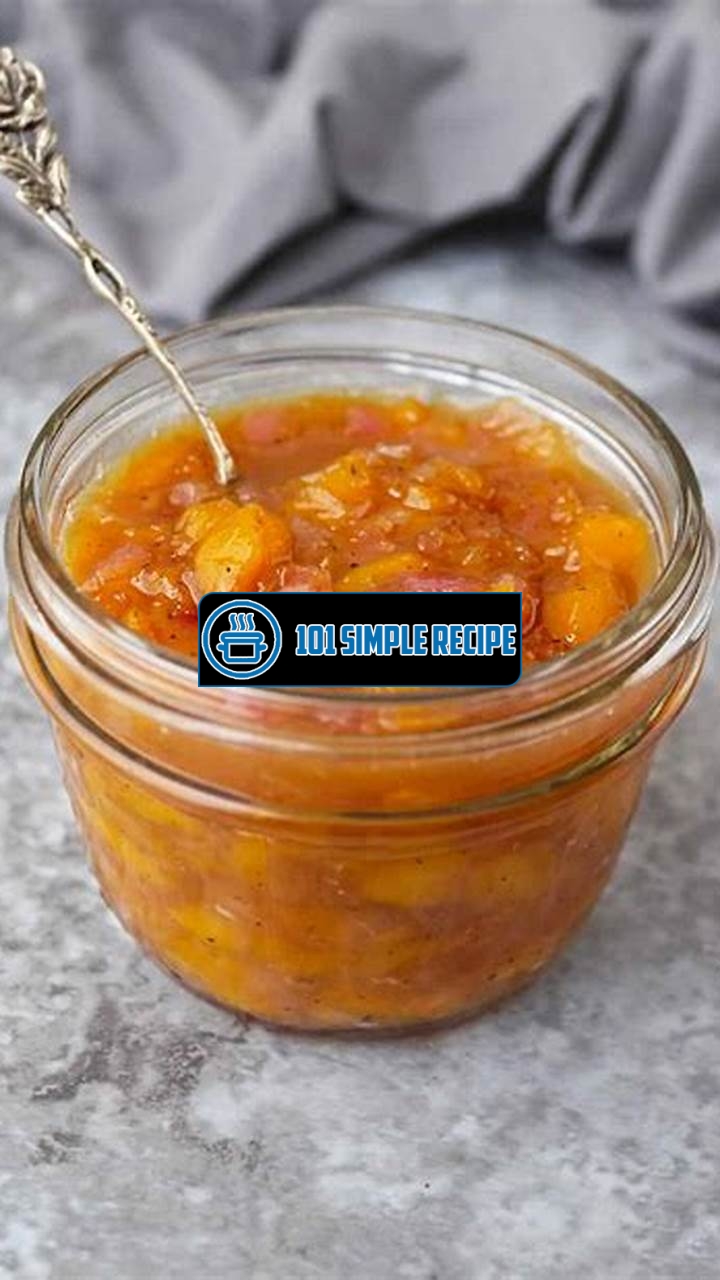Welcome to the world of delicious homemade mango chutney! ️ If you’ve been craving the perfect combination of sweet, tangy, and spicy flavors, this easy recipe is just what you need. With simple ingredients and straightforward steps, you can create a mouth-watering condiment that will elevate your dishes to new heights. Whether you’re a seasoned cook or a beginner in the kitchen, this recipe will guide you through the process with ease. So grab your apron and let’s dive into the world of homemade mango chutney!

The History of Mango Chutney
Discover the origins of mango chutney and its cultural significance in various cuisines across the globe.
The Evolution of Mango Chutney
Mango chutney, a delicious and versatile condiment, has a rich history that dates back centuries. Its origin can be traced to the Indian subcontinent, where it was first made by combining mangoes with spices and vinegar. Over time, the recipe evolved and spread to different parts of the world, adapting to local tastes and ingredients.
Initially, mango chutney was primarily a way to preserve the abundant mango harvest in India. By combining ripe mangoes with sugar, vinegar, and spices such as ginger, garlic, and chili, the fruit could be enjoyed long after its season had ended. The sweet and tangy flavor profile of mango chutney soon caught on, and it became a staple in Indian cuisine.
The popularity of mango chutney quickly spread beyond India’s borders. During the colonial period, the British developed a taste for this unique condiment and introduced it to their homeland. It gained popularity among the British elite and became a common accompaniment to their meals, particularly with curry dishes.
As trade routes expanded and cultural exchanges flourished, mango chutney found its way into various international cuisines. In the Caribbean, for example, mango chutney became a beloved ingredient in jerk chicken recipes, adding a burst of tropical flavor. Similarly, in Southeast Asian countries like Thailand and Malaysia, mango chutney is used as a dipping sauce for fried snacks and spring rolls.
Mango Chutney in Indian Cuisine
In Indian cuisine, mango chutney occupies a special place. It is not only a delicious condiment but also a symbol of hospitality and warmth. Traditionally, mango chutney is prepared during the summer months when mangoes are plentiful. The process involves peeling and cutting ripe mangoes, then simmering them with spices, sugar, and vinegar until the mixture thickens.
Mango chutney is incredibly versatile and can be enjoyed in various ways. It can be used as a dip for samosas and pakoras, spread on sandwiches, or served alongside curries and biryanis. Its sweet and tangy taste adds a delightful contrast to spicy dishes and helps balance the flavors of a meal.
Mango Chutney in International Cuisines
Besides its popularity in Indian cuisine, mango chutney has become a beloved ingredient in international dishes. In British cuisine, it is often served with cheese and crackers as part of a ploughman’s lunch or in sandwiches. In the United States, mango chutney is used as a glaze for grilled meats, such as chicken or pork, adding a tropical twist to savory dishes.
Furthermore, mango chutney has found its way into fusion cuisines. Chefs around the world experiment with incorporating mango chutney into different recipes, creating unique and delicious flavor combinations. From mango chutney-infused sushi rolls to mango chutney-marinated grilled tofu, the possibilities are endless.
In conclusion, mango chutney is not just a condiment; it is a culinary treasure with a fascinating history. Its evolution from a simple preservation technique to a global phenomenon speaks to its versatility and appeal. So, the next time you savor a spoonful of mango chutney, remember the rich heritage and cultural significance it carries.
Health Benefits of Homemade Mango Chutney
When it comes to enjoying delicious homemade mango chutney, the benefits extend beyond just its incredible taste. This flavor-packed condiment can actually contribute to your overall well-being in several ways. From being rich in essential vitamins and minerals to aiding digestion and promoting gut health, homemade mango chutney has a range of health benefits that make it a worthy addition to your diet.
Rich in Vitamins and Minerals
Mangoes, the main ingredient in homemade mango chutney, are a powerhouse of essential vitamins and minerals that are crucial for maintaining good health. These juicy tropical fruits are packed with immune-boosting vitamin C, which helps protect against common illnesses such as colds and flu. They are also a rich source of vitamin A, which is important for maintaining healthy vision, promoting cell growth, and supporting the immune system.
In addition to vitamins, mangoes also provide important minerals like potassium and magnesium. Potassium plays a vital role in maintaining proper heart function and a healthy blood pressure level. It also helps regulate fluid balance and supports muscle function. Magnesium, on the other hand, is involved in over 300 biochemical reactions in the body, including energy production, nerve function, and the synthesis of DNA and proteins.
Tip: By enjoying homemade mango chutney, you can easily incorporate these vital vitamins and minerals into your diet in a delicious way.
Aids Digestion and Gut Health
Another remarkable benefit of mango chutney is its ability to aid digestion and promote gut health. Mangoes contain dietary fiber, which is essential for maintaining a healthy digestive system. Fiber helps regulate bowel movements, prevents constipation, and keeps your digestive tract functioning smoothly.
Moreover, mangoes also contain enzymes, such as amylases and proteases, which help break down proteins and improve overall digestion. These enzymes assist in the efficient absorption and assimilation of nutrients, ensuring that your body can make the most of the food you consume.
Fun fact: The fiber content in mangoes acts as a natural detoxifier, helping to eliminate waste and toxins from the body.
Potential Antioxidant Properties
Homemade mango chutney may also offer potential antioxidant properties. Mangoes are known to be a rich source of antioxidants, which help protect the body against harmful free radicals. Free radicals can cause oxidative stress and damage to cells, leading to various health issues.
Antioxidants like vitamin C and beta-carotene in mangoes can neutralize these free radicals and reduce the risk of chronic diseases like heart disease, cancer, and age-related macular degeneration. By incorporating mango chutney into your diet, you can boost your antioxidant intake and enhance your body’s defense against oxidative damage.
✨ Pro-tip: Opting for homemade mango chutney ensures that you get the maximum antioxidant benefits, as store-bought versions may contain added sugars and preservatives that can diminish the overall nutritional value.
In conclusion, homemade mango chutney not only adds a burst of flavor to your meals but also provides significant health benefits. With its high vitamin and mineral content, ability to aid digestion, and potential antioxidant properties, this vibrant condiment can contribute to your overall well-being. So, go ahead and indulge in a delicious spoonful of homemade mango chutney, knowing that you’re nourishing your body with wholesome goodness.
Mastering the Mango Selection Process
When it comes to creating a delicious and flavorsome mango chutney, choosing the right mangoes is crucial. The taste and texture of your chutney will greatly depend on the type and ripeness of the mangoes you select. In this section, we will provide you with key tips on how to master the mango selection process, ensuring a mouthwatering chutney every time.
Identifying Ripe Mangoes
Before you start making your homemade mango chutney, it is essential to know how to identify ripe mangoes. Here are some tips to help you:
- Color: Ripe mangoes often have a vibrant color, varying from greenish-yellow to bright orange or red.
- Texture: Gently squeeze the mango to check for a slight give. Avoid mangoes that are too hard or too soft.
- Aroma: A ripe mango will have a sweet and fragrant smell at the stem end.
- Weight: Ripe mangoes tend to be heavier due to their juicy flesh. Pick up the mango and feel its weight in your hand.
Important Note: Ensure that your mangoes are not overripe, as they may become mushy and affect the overall texture of your chutney.
The Best Mango Varieties for Chutney
While there are numerous mango varieties available, not all are suitable for making chutney. Here are some of the best mango varieties to consider:
- Alphonso: Known as the “king of mangoes,” Alphonso mangoes have a rich and tropical flavor, making them ideal for chutney.
- Kesar: With its sweet and tangy taste, Kesar mangoes are another excellent choice for chutney.
- Tommy Atkins: This variety is widely available and has a mild, slightly sweet flavor that works well in chutney.
- Francis: Francis mangoes are known for their aromatic flavor and are often used in Caribbean cuisine, including chutney recipes.
Important Note: Experiment with different mango varieties to find your favorite flavor profile for chutney. Each mango variety offers a unique taste.
Handling and Storing Mangoes
Once you have selected the perfect mangoes, it is essential to handle and store them properly to maintain their quality. Here are some tips:
- Washing: Before using your mangoes, wash them thoroughly under cool running water to remove any dirt or residue.
- Peeling and Pitting: Use a sharp knife to carefully peel the skin off the mango and remove the pit.
- Storing: If your mangoes are not yet ripe, store them at room temperature in a paper bag to speed up the ripening process. Once ripe, refrigerate them to extend their shelf life.
Important Note: Always handle mangoes with care as they can be slippery. Use caution when peeling and pitting to avoid accidents.
In conclusion, the process of mastering the mango selection for your homemade chutney is key to achieving a delectable outcome. By identifying ripe mangoes, selecting the best mango varieties, and handling and storing them properly, you can ensure the success of your mango chutney recipe.
Essential Ingredients for Homemade Mango Chutney
Gain insights into the key ingredients required to create the perfect balance of flavors in your homemade mango chutney.
Understanding the Role of Mangoes
Mangoes are the star of any mango chutney recipe, and they play a vital role in creating its delicious flavor. These tropical fruits bring a sweet and tangy taste, as well as a rich texture to the chutney. When selecting mangoes for your homemade chutney, make sure they are ripe but not overly soft. The level of ripeness will impact the final taste and texture of your chutney.
In addition to their delightful taste, mangoes also pack a nutritional punch. They are a great source of vitamin C, vitamin A, and fiber. By adding mangoes to your chutney, you’ll not only enhance the flavor but also boost its nutritional value.
Adding Spices for Depth and Aroma
Spices are crucial in creating a well-rounded and flavorful mango chutney. They add depth, aroma, and complexity to the overall taste profile. The selection and combination of spices can vary depending on personal preference, but some common ones include:
- Cumin: A warm spice that brings earthiness and a slightly nutty flavor to the chutney. It pairs exceptionally well with the sweetness of mangoes.
- Coriander: Known for its citrusy, slightly floral taste, coriander adds brightness and freshness to the chutney.
- Mustard seeds: These tiny seeds provide a subtle crunch and a mildly spicy kick to the chutney.
- Cinnamon: A versatile spice that lends warmth and a hint of sweetness, enhancing the overall flavor profile of the chutney.
Experimenting with different spice combinations can help you personalize your mango chutney according to your taste preferences. Don’t be afraid to get creative and adjust the spice levels to suit your palate.
Enhancing Flavor with Sweeteners and Vinegar
Sweeteners and vinegar are essential ingredients that contribute to the overall flavor balance and preservation of homemade mango chutney.
Sweeteners: Traditional mango chutney recipes often use sugar or jaggery (a type of unrefined sugar) as the sweetener. The sweetness helps counterbalance the tanginess of the mangoes and the acidity of the vinegar. You can also experiment with alternative natural sweeteners like honey or maple syrup for a different flavor profile.
Vinegar: Adding vinegar to your mango chutney not only imparts a tangy taste but also acts as a natural preservative, extending the shelf life of the chutney. Commonly used vinegars include apple cider vinegar and white vinegar. The choice of vinegar can impact the final flavor, so choose one that complements the overall taste profile.
By understanding the role of mangoes, adding spices for depth and aroma, and enhancing flavor with sweeteners and vinegar, you’ll be on your way to creating a delicious homemade mango chutney. Adjust the ingredients to suit your taste and let your culinary creativity shine. Happy chutney making! ️
Step-by-Step Guide to Making Mango Chutney
Follow a detailed and easy-to-understand recipe to create your own homemade mango chutney from scratch. This delicious condiment is perfect for adding a sweet and tangy flavor to your favorite dishes. With just a few simple steps, you can enjoy the flavorful combination of ripe mangoes, aromatic spices, and a hint of heat. Let’s dive into the process of making this delightful mango chutney.
Preparing the Mangoes
To begin, choose ripe and sweet mangoes for the best flavor. Peel the mangoes and remove the pits, then dice them into small, uniform pieces. This ensures that the mango chutney has a smooth and consistent texture.
Next, gather the necessary ingredients for the chutney. Apart from mangoes, you will need onions, sugar, vinegar, ginger, garlic, mustard seeds, red chili flakes, and various spices. These ingredients work together to create a flavorful and well-balanced chutney.
Cooking and Simmering the Chutney
In a large saucepan, heat some oil and add mustard seeds. Once they start to crackle, add chopped onions and sauté until they turn translucent.
Add minced ginger and garlic to the pan, along with red chili flakes and the spices of your choice. This will infuse the chutney with a delightful aroma and enhance the overall taste. Allow the mixture to cook for a few minutes, stirring continuously. ️
Now, it’s time to add the diced mangoes to the pan. Stir well to coat the mangoes with the aromatic spice mixture. As the mangoes soften, they release their natural sweetness, complementing the spices and creating a balanced flavor profile.
Pour in the sugar and vinegar, and bring the mixture to a simmer. Reduce the heat and let it cook for about 30 minutes, or until the chutney thickens to your desired consistency. The slow cooking process allows the flavors to meld together and intensify. Stir occasionally to prevent sticking. ⏰
Jarring and Storing the Chutney
Once the chutney reaches the desired consistency, it is ready to be stored. Prepare sterilized jars by washing them thoroughly and drying them in a hot oven.
Carefully ladle the hot chutney into the jars, leaving a small gap at the top. This space allows for expansion as the chutney cools. Seal the jars tightly and let them cool completely before storing them in a cool, dark place. The chutney will continue to develop its flavors over time.
When stored properly, homemade mango chutney can last for several months. Once opened, be sure to refrigerate the chutney to maintain its freshness. Enjoy this delightful condiment with your favorite dishes, such as curries, sandwiches, or grilled meats. ️
Creating your own homemade mango chutney is a rewarding experience. With this simple and detailed recipe, you can enjoy the sweet and tangy flavors anytime you desire. Get creative and personalize the chutney by adding your favorite spices or adjusting the level of heat. Experimentation is key to finding the perfect balance of flavors that suits your taste. Happy chutney-making!
Frequently Asked Questions
Here are some frequently asked questions about homemade mango chutney:
| No. | Questions | Answers |
|---|---|---|
| 1. | How long does homemade mango chutney last? | Homemade mango chutney can last for up to 3 months when stored in an airtight container in the refrigerator. Make sure to check for signs of spoilage before consuming. |
| 2. | Can I adjust the spice level of the chutney? | Yes, you can adjust the spice level of the chutney by adding more or less chili pepper. Start with a small amount and taste as you go to achieve the desired level of spiciness. |
| 3. | What can I serve homemade mango chutney with? | Homemade mango chutney pairs well with a variety of dishes such as grilled chicken, roasted pork, cheese platters, or even as a spread on sandwiches. Get creative and explore different flavor combinations! |
| 4. | Can I use frozen mangoes instead of fresh? | Yes, you can use frozen mangoes to make homemade mango chutney. Just make sure to thaw the mangoes before using them in the recipe. |
| 5. | How can I make the chutney less sweet? | To make the chutney less sweet, you can reduce the amount of sugar used in the recipe or add a splash of vinegar to balance the sweetness. Adjust according to your taste preferences. |
| 6. | Can I can homemade mango chutney for long-term storage? | Yes, you can preserve homemade mango chutney through canning methods to extend its shelf life. Follow proper canning procedures and make sure the jars are sealed tightly. |
Thank You for Reading!
We hope you enjoyed learning how to make homemade mango chutney. Now that you have the recipe, why not give it a try? It’s a delicious condiment that adds a burst of flavor to your meals. Remember, practice makes perfect, so don’t be discouraged if your first attempt isn’t perfect. Keep experimenting and adjusting the recipe to suit your taste. If you have any more questions or need further assistance, feel free to visit our website again. Happy cooking! ️
Jump to Recipe
Homemade Mango Chutney Recipe

Learn how to make a delicious homemade mango chutney with this easy recipe. This sweet and tangy condiment is perfect for adding a burst of flavor to your meals. Serve it with grilled chicken, roasted pork, cheese platters, or as a spread on sandwiches. Get ready to elevate your taste buds to a whole new level!
- 2 ripe mangoes (peeled and diced)
- 1 onion (finely chopped)
- 1 red bell pepper (diced)
- 1 green chili pepper (minced)
- 1 cup white sugar
- 1 cup white vinegar
- 1 tablespoon ginger (grated)
- 1 teaspoon mustard seeds
- 1 teaspoon turmeric powder
- 1 teaspoon red chili flakes
- Salt to taste
- In a large saucepan, combine the diced mangoes, chopped onion, bell pepper, and green chili pepper.
- Add the white sugar, white vinegar, grated ginger, mustard seeds, turmeric powder, red chili flakes, and salt to taste.
- Stir well to combine all the ingredients.
- Bring the mixture to a boil over medium heat, then reduce the heat and let it simmer for about 40 minutes or until the chutney thickens.
- Remove from heat and let the chutney cool completely.
- Transfer the chutney to sterilized jars and seal tightly.
- Store in the refrigerator for up to 3 months.
- Serve and enjoy!






